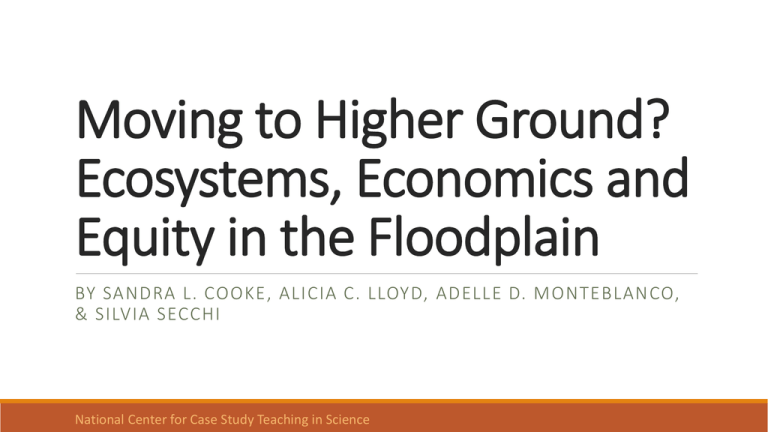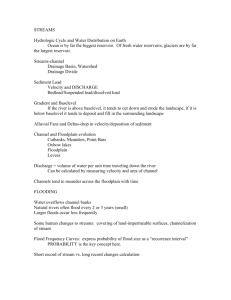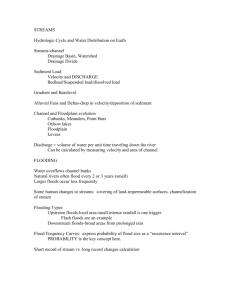Moving to Higher Ground? Ecosystems, Economics and Equity in the Floodplain
advertisement

Moving to Higher Ground? Ecosystems, Economics and Equity in the Floodplain BY SANDRA L. COOKE, ALICIA C. LLOYD, ADELLE D. MONTEBLANCO, & SILVIA SECCHI National Center for Case Study Teaching in Science Welcome to Olive Branch, Illinois • Unincorporated community located in the Mississippi River floodplain in Southern Illinois • Experienced major floods in 1993 and 2011 • • • • Extensive and costly damage Devastating effects on the town of Olive Branch Over 150 homes and businesses severely damaged, many demolished Years later, the community has yet to recover 2 Mississippi River Flood Management • System of levees (or man-made embankments) meant to confine the river so it can be used for transportation and to reduce flooding of adjacent agricultural land and in communities developed in the floodplain • Management activities not only affect people living and working in the floodplain, but also have political and economic impacts that extend beyond the floodplain • Diverse interests, such as those of conservation scientists, agricultural producers, outdoor recreationalists, and taxpayers, all have different stakes in how the community of Olive Branch recovers from the severe flood damages of 2011 and addresses future flood events 3 Levees and Flood Management •While the levee system keeps floodwaters from inundating the floodplain and allows for farming and urban development on the land bordering the river, human-made alterations to the lower Mississippi create barriers that sever the river from its floodplain •Benefits of floodplain connectivity and natural, periodic flooding: • Habitat for fish and wildlife • Enhances water quality by filtering runoff before it enters the waterway • Actually reduces flooding by storing overflow waters and maintaining the river structure • Provides open space natural land uses that include recreational opportunities such as hunting and fishing 4 Flooding of 2011 5 6 Local Photos Photos from the 2011 flood. Photos courtesy of Beth Ellison, Southern Illinois University. 7 Local Photos The town of Metropolis, near Olive Branch, during the 2011 flood (left) and Olive Branch homes during the 2011 flood (right). Photos courtesy of Jonathan W. Remo. 8 The Issue •The town of Olive Branch is still reeling from the 2011 flood. •A slow exodus of some residents has occurred, but many of the remaining citizens have close ties to the area and would love to see Olive Branch make a comeback. •The town has been able to secure funding for a buyout of the properties on the floodplain to help the displaced move to higher ground. However, for the buyout to be implemented, the State of Illinois has to provide 25% cost share funds and the benefits have to outweigh the costs. In practice, this means that more than two-thirds of local residents must agree to the buyout, actually sell their property and rebuild in a new chosen location close to town but outside the floodplain. A decision must be made about the future of the community. 9 3 Options •There are three alternative plans on the table, each with pros and cons. They are: •Do nothing option. Do not relocate the town. Residents could decide on their own whether to rebuild their houses on site, move their houses to higher ground or relocate somewhere else. If this is the chosen option, the buyout money would not be usable, though some residents may be able to obtain individual funding to repair their properties. Note that buyout funds are Federal; individual funding for repairs would have to come from the state or the county. •Restoration option. Relocate the town to higher ground and implement a restoration project that would have both conservation and recreational benefits. Biodiversity and habitat quality of floodplain forests, wetlands, and Horseshoe Lake – a popular recreation area – would be enhanced, and recreational opportunities would be improved. Specifically, since habitat for waterfowl has decreased, this option would reclaim agricultural land in the area for waterfowl habitat. Funding from the buyout would have to be supplemented with restoration funding from state and county sources, and/or private and nonprofit organizations (such as Ducks Unlimited), to buy land from farmers. •Agricultural enhancement option. Relocate the town to higher ground without restoring habitat. However, because properties would be bought back, and either no residents or very few residents left on the floodplain, there would be more land available for agricultural activities on the floodplain. Money from the buyout program would not need to be supplemented with other funds. 10 Case Study Assignment •Your ultimate goal is to work in a “consensus-building team” to write a 500-700 word letter to your state senator based Chicago who chairs the committee that needs to approve the 25% cost share. • This letter should include four main components: (1) a clear, thorough explanation of the issue, including the environmental, societal, economic, and other aspects; (2) a recommendation for which of the three options above is best, (3) a description of the benefits, drawbacks, and other tradeoffs that would be made if the option is adopted, and (4) an outline of the types of information or data that will need to be monitored to ensure the plan’s success. • But first….. 11 Part I •You will receive a position statement for one of the following four stakeholders: • • • • Conservation biologists Hunters/recreationalists Farmers Local residents/property owners •Your goal in this activity will be to put yourself in your assigned character’s shoes as best you can, even if your character’s interests may not align with your own personal viewpoint. •Take a few minutes to read your stakeholder’s position statement and then gather together with other students representing your assigned stakeholder (this is the “stakeholder group,” not the “consensus-building team,” which will form later). Also take a few minutes to review the key issue at hand and the three options being considered. In your stakeholder group discuss the following: • Given your background and values, which of the three options would be best for you and why? • What tradeoffs would you have to make if the other two scenarios were adopted instead (in other words, what are the pros and cons of each scenario)? • Rate your willingness to make each of these tradeoffs. Make sure you know what you want but are also prepared to negotiate with other stakeholders. 12 Part II •Next, your instructor will assign you to a “consensus-building team” comprised of one representative from each of the four stakeholder groups. In your team complete the following: • Allow each representative 1-2 minutes to introduce themselves – give your name and background information. • Next, allow each representative 4-5 minutes to explain which option they support and why. • Try to decide upon the option that your group thinks will best meet everyone’s needs and desires. Of course, there will be benefits and drawbacks to whichever option you agree upon. Compile a list of these major benefits and drawbacks, as these will help you write your letter. 13 Part III •As a group, your consensus building team should now write a letter to the state senator based in Chicago. Your letter must include the following components: •Explanation of the environmental, societal, and economic aspects of the issue. Assume that your audience – the senator – is completely unaware of Olive Branch’s dilemma. In your own words (i.e., without quoting the introduction to this exercise), describe the situation that Olive Branch is facing. Be sure to convey to the senator how this is not merely an environmental restoration issue, but a community problem that has local economic and societal ramifications. •Recommendation for the best option. Clearly state the option that your team thinks is best. •Benefits and drawbacks of this option. Why is this the best option? Show the senator that you are thoughtful citizens who have considered multiple perspectives on the issue. Lay out the benefits and drawbacks. •How to proceed. Think of the types of information or data that will need to be collected and monitored to ensure the plan’s success. Even if your team argues that the town should not be moved, are there any economic, environmental, or other types of indicators that should be tracked to ensure that the community is prospering? 14 Part IV Your instructor may ask you to select a representative from your team to read aloud your letter to the class. • Listen as other teams read their letters. • Did other teams make different decisions? • How did their rationale compare to yours? 15 Debrief •Your instructor will moderate a class discussion and reflection. 16 Update (2014) of Olive Branch, Illinois •Since Olive Branch is not incorporated, on behalf of the community, Alexander County applied to the Federal Emergency Management Agency (FEMA) for a grant to support the buyout in September 2011. The grant was awarded in the Spring of 2013. •The buyout involves over 130 properties, and the cost of the relocation is estimated at around $12 million. The FEMA grant provides 75% of the funds, and the remaining 25% will be given by the State of Illinois. •The appraisals of involved properties are still ongoing as of the Summer of 2014, and they are not all completed. The appraisals determine the amount of money to be awarded to all community members involved, and have to be approved by the State, so even after that part of the process is completed, the landowners have to wait for the funding to be approved. Once a property has been approved, a restriction is put on the deed forbidding from building on the property. Some of the properties will likely become farmland and others will just remain open spaces. No large tracts of land above the floodplain have yet been bought to relocate residents. 17





